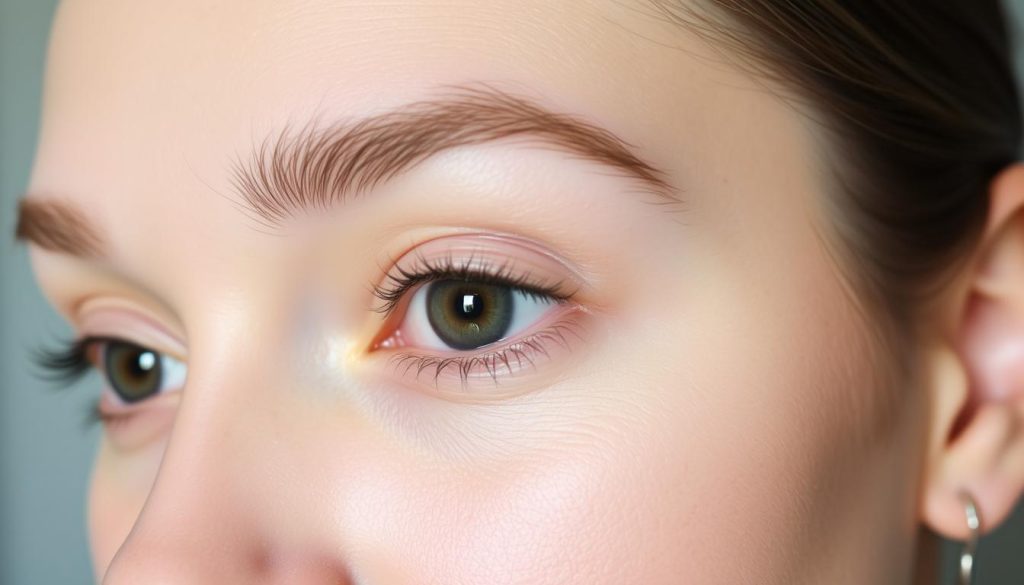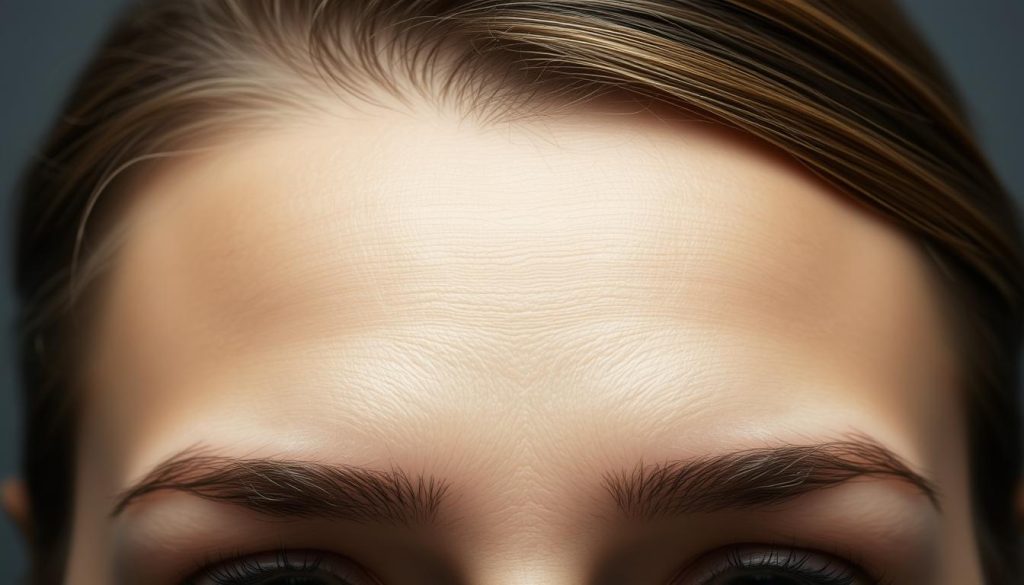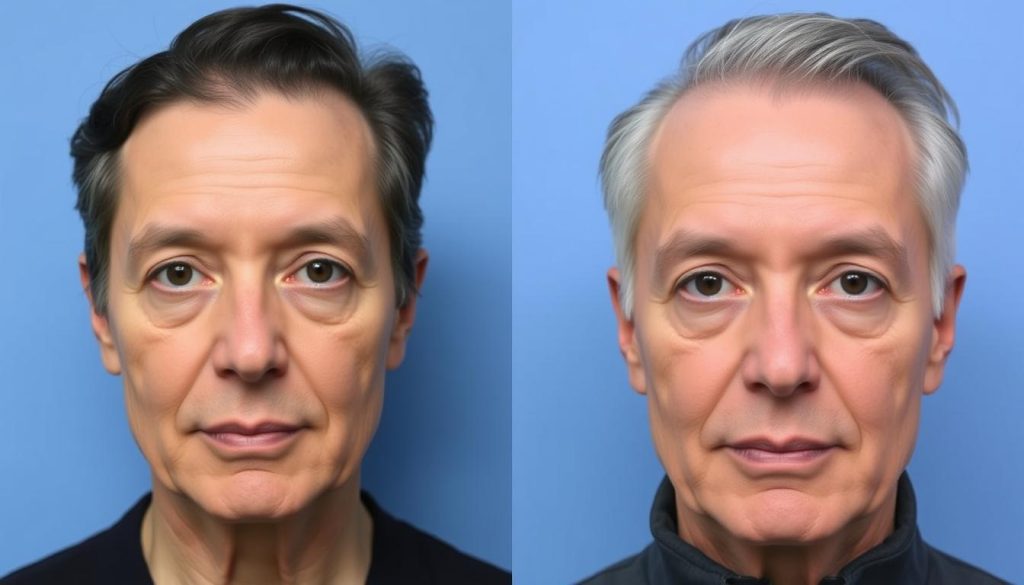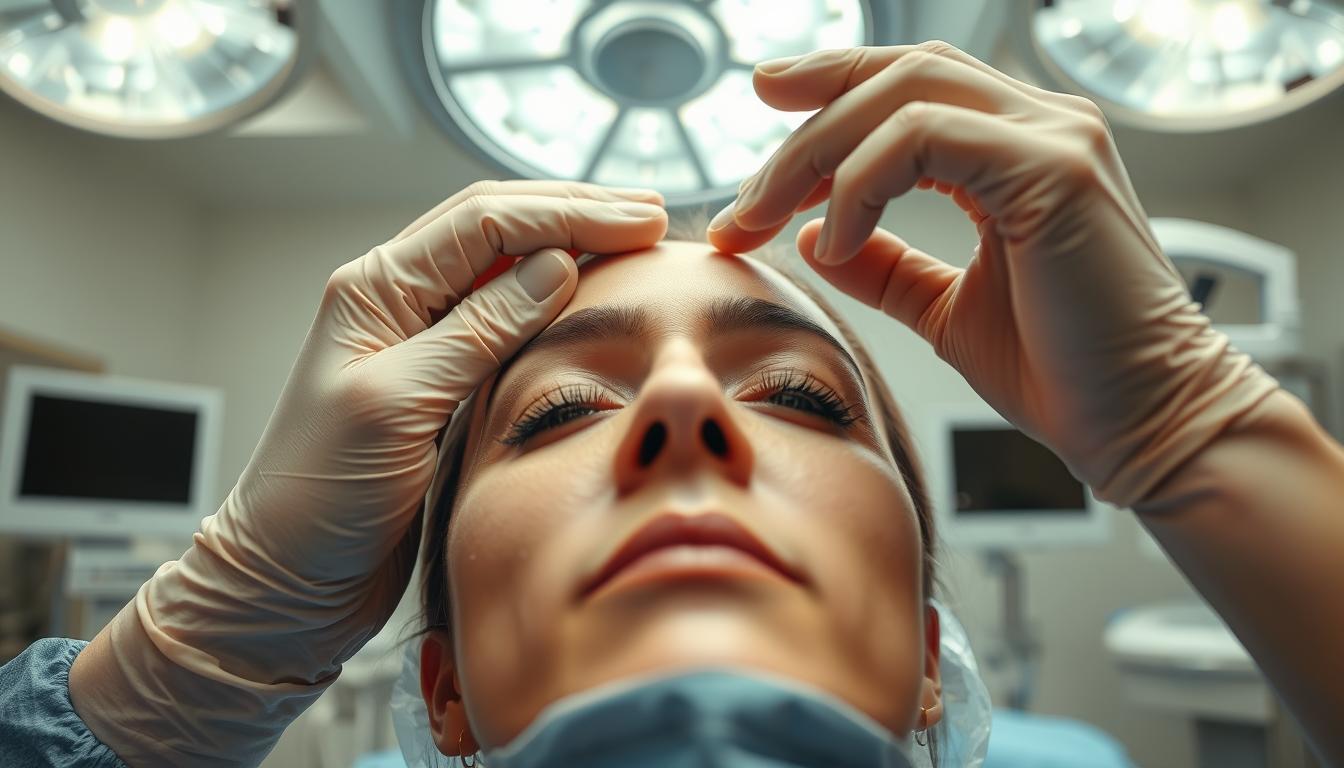A high hairline or excessively large forehead can be a source of self-consciousness for many individuals, affecting their overall facial aesthetics and perceived age.
Forehead reduction surgery, also known as hairline lowering, is a specialized cosmetic procedure designed to create more balanced facial proportions by reducing the size of the forehead.
This surgical technique addresses concerns related to a high or prominent forehead that may cause dissatisfaction with one’s appearance. By surgically advancing the hairline, the procedure creates a more harmonious facial aesthetic, making it an attractive option for patients seeking to improve their facial balance.
Key Takeaways
- Forehead reduction surgery is a cosmetic procedure that lowers the hairline to achieve more balanced facial proportions.
- The surgery addresses concerns related to a high or prominent forehead, enhancing overall facial aesthetics.
- Patients seeking this procedure often desire a more proportionate face with improved balance between facial features.
- The process involves a comprehensive assessment of candidacy, followed by the surgical procedure and a recovery period.
- Understanding the details of forehead reduction surgery is crucial for making an informed decision about undergoing this transformative procedure.
Understanding Forehead Reduction Surgery
By surgically lowering the hairline, forehead reduction surgery can create a more balanced facial aesthetic. This procedure is gaining popularity among individuals seeking to enhance their facial harmony.
What Is Forehead Reduction?
Forehead reduction, also known as hairline lowering, is a surgical procedure designed to reduce the height of the forehead by advancing the scalp. This technique is particularly beneficial for individuals with a high hairline, offering a more proportionate facial appearance.
Benefits of Hairline Lowering
The benefits of undergoing hairline lowering surgery are multifaceted. Not only does it enhance facial harmony, but it also improves self-confidence and contributes to a more youthful appearance. Key advantages include:
- Enhanced facial proportions
- Improved self-esteem
- A more youthful and vibrant look
- Permanent results
To further illustrate the benefits and aspects of forehead reduction surgery, consider the following comparative table:
| Aspect | Before Surgery | After Surgery |
|---|---|---|
| Forehead Height | Typically higher | Reduced, more proportionate |
| Facial Harmony | May appear imbalanced | Enhanced, more balanced |
| Self-Confidence | May be lower due to aesthetic concerns | Improved due to enhanced appearance |
Ideal Candidates for Forehead Reduction

Individuals considering forehead reduction should understand the specific requirements that make them ideal candidates. Forehead reduction surgery is a significant decision that requires careful consideration of both physical characteristics and aesthetic goals.
Physical Requirements
Good candidates for forehead reduction typically have good scalp elasticity, which allows for sufficient advancement of the hairline. They should also have a stable hairline without signs of progressive hair loss.
Aesthetic Concerns Addressed
The procedure addresses aesthetic concerns including excessive forehead height, facial imbalance, and self-consciousness about forehead appearance. Individuals with a naturally high hairline or large forehead that creates facial disproportion can benefit from this surgery.
- Ideal candidates have good scalp elasticity.
- A stable hairline is essential for long-term success.
- Patients often have a naturally high hairline or large forehead.
- The procedure addresses excessive forehead height and facial imbalance.
- Individuals with good overall health and realistic expectations make the best candidates.
- Those with thin hair or limited scalp mobility may need alternative approaches.
The Forehead Reduction Procedure Explained

Understanding the forehead reduction procedure is crucial for potential candidates. The surgery involves a series of precise steps to achieve the desired outcome.
Surgical Technique
The surgical technique for forehead reduction involves making an incision along the existing hairline in an irregular pattern. This approach helps ensure a natural-looking result. After the incision is made, the surgeon advances the scalp forward to create the new hairline position.
Anesthesia and Duration
Forehead reduction surgery is typically performed under general anesthesia and is an outpatient procedure. The surgery usually takes around two hours to complete, though it can vary depending on the complexity of the case. The reduction achieved through this surgery can significantly alter the appearance of the forehead.
Forehead Reduction vs. Hair Transplantation
When considering hairline correction, patients often weigh the benefits of forehead reduction against hair transplantation. Both procedures aim to improve the appearance of the hairline, but they differ significantly in their approach and outcomes.
Comparing Effectiveness
Forehead reduction involves surgically advancing the hairline forward, providing immediate results for those with a high hairline and good hair density. In contrast, hair transplantation relocates individual hair follicles to create density, often requiring multiple sessions. Forehead reduction can achieve a fuller hairline in a single procedure, making it a more immediate solution for suitable candidates.
Cost Considerations
The cost of forehead reduction and hair transplantation varies significantly. While forehead reduction can be more cost-effective in the short term, hair transplantation may require multiple sessions, increasing overall expenses. Patients should consider their budget and the potential need for future procedures when deciding between these options. According to experts, “Some patients experience a reduction in future hair loss after hairline lowering or forehead reduction surgery,” which can impact long-term costs.

What to Expect During Your Consultation

Understanding what to expect during your consultation is vital for a successful forehead reduction procedure. This initial meeting with your surgeon is an opportunity to discuss your aesthetic goals and gain a deeper understanding of the procedure.
During the consultation, the surgeon will evaluate your hairline, forehead proportions, scalp elasticity, and overall facial structure to determine if you’re a suitable candidate for forehead reduction.
Important Questions to Ask
It’s essential to come prepared with questions for your surgeon. Ask about their experience with forehead reduction, expected results, potential complications, and the recovery timeline to ensure you’re in good hands.
Setting Realistic Expectations
Setting realistic expectations is crucial for satisfaction with your hairline lowering outcome. Your surgeon should provide honest feedback about achievable results based on your unique anatomy, helping you understand what to expect from the procedure.
The Recovery Process After Forehead Reduction

Recovery after forehead reduction is a multi-faceted process that involves physical healing and patience. The recovery process is crucial for achieving the desired outcome from the hairline lowering procedure.
First Week After Surgery
During the first week after forehead reduction surgery, patients typically experience swelling, bruising, and temporary numbness in the forehead and scalp region. Managing these symptoms is key to a smooth recovery.
Long-Term Healing Timeline
The long-term healing timeline extends over several months. Initial swelling subsides within 2-3 weeks, but complete resolution of all symptoms may take up to 6 months. Patience is essential during this period.
Managing Discomfort
Managing discomfort is generally straightforward with prescribed medications. Most patients report their discomfort as moderate and manageable, allowing them to return to work and social activities within 1-2 weeks.
The recovery process after forehead reduction surgery follows a predictable timeline, though individual healing experiences may vary. Key aspects include:
- Swelling, bruising, and numbness in the first week
- Sutures removed between 7-10 days post-surgery
- Initial swelling subsides within 2-3 weeks
- Complete resolution of symptoms within 6 months
- Return to work and social activities within 1-2 weeks
- Avoiding strenuous exercise for at least 3-4 weeks
- Gradual improvement in scar appearance over 6-12 months
By understanding the recovery process, patients can better prepare themselves for the journey ahead, ensuring a successful outcome from their forehead reduction procedure.
Potential Results from Hairline Lowering Surgery

Patients undergoing forehead reduction surgery often experience a transformative change in their facial aesthetics. Dr. Kornstein performs this surgery with precision, gently shifting the natural hairline to the preferred placement.
Typical Aesthetic Improvements
Typical aesthetic improvements include a more feminine hairline shape for women, enhanced facial harmony, and a more youthful appearance. The procedure creates a more balanced facial appearance by improving the proportions between the forehead and other facial features.
Longevity of Results
The results from forehead reduction are permanent, as the hairline is physically repositioned to a lower position on the face. Hair will grow naturally through and in front of the incision line, further camouflaging any evidence of surgery and enhancing the natural appearance.
The way the hairline frames the face after surgery creates a more balanced and harmonious overall facial aesthetic. Most patients report high satisfaction with their results, noting increased confidence and reduced self-consciousness about their forehead appearance.
Scarring and Incision Placement
Understanding the nature of scarring and incision placement is vital for individuals contemplating forehead reduction. The procedure involves making an incision along the hairline, which is a critical factor in determining the visibility of the scar post-surgery.

The resulting scar from forehead reduction surgery is typically thin and virtually invisible on the front of the scalp. Within weeks, the scar fades significantly, and over time, hair growth further conceals it, making the scar practically undetectable.
Scar Visibility Concerns
Scar visibility is a major concern for patients undergoing hairline lowering procedures. Skilled surgeons address this by creating irregular, beveled incisions that follow the natural hairline pattern, allowing hair to grow through and in front of the scar for optimal concealment.
- Incisions are made within or just behind the hairline.
- Modern techniques focus on tension-free closures to minimize scarring.
Techniques for Minimizing Scarring
Techniques for minimizing scarring include trichophytic incisions that allow hair to grow through the scar and careful management of tension during scalp advancement. Post-operative scar care, such as silicone-based treatments and sun protection, can also significantly improve the final appearance of the incision line.
- Trichophytic incisions promote hair growth through the scar.
- Proper post-operative care enhances the healing process.
Risks and Considerations
Forehead reduction surgery, like any other surgical procedure, comes with its own set of risks and considerations that patients must be aware of before undergoing the operation.
Potential Complications
Potential complications associated with forehead reduction include infection, bleeding, adverse reactions to anesthesia, temporary or permanent numbness, and hair loss along the incision line. Some patients may experience widening of the scar over time, particularly if there is excessive tension on the scalp advancement.
Selecting a Qualified Surgeon
Selecting a qualified surgeon with specific experience in hairline lowering and plastic surgery of the face is crucial for minimizing risks and achieving optimal results. Patients should seek surgeons who are board-certified in plastic surgery or facial plastic surgery and who regularly perform forehead reduction procedures.
- Ensure the surgeon has experience with forehead reduction surgery.
- Discuss individual risk factors based on medical history and scalp characteristics.
- Understand the limitations of the procedure and potential outcomes.
| Risk Factor | Description | Mitigation Strategy |
|---|---|---|
| Infection | Bacterial or viral infection post-surgery | Antibiotics, proper wound care |
| Hair Loss | Loss of hair along the incision line | Careful surgical technique, post-op care |
| Scar Widening | Widening of the scar due to tension | Minimizing tension on the scalp, proper suturing |
Schedule Your Forehead Reduction Consultation Today

Discover how forehead reduction surgery can enhance your facial proportions by scheduling a consultation with Dr. Vila today. During your consultation, you’ll receive personalized information about how hairline lowering surgery can address your specific aesthetic concerns and enhance your facial proportions.
Our office provides comprehensive consultations where you can discuss your goals, ask questions about the procedure, and learn about recovery expectations in detail. The surgeon will evaluate your scalp elasticity, hair density, and overall facial structure to determine if you’re an ideal candidate for forehead reduction surgery.
Schedule your appointment today and take the first step toward a more balanced facial appearance through advanced forehead reduction techniques.
FAQ
What is the ideal age for undergoing hairline lowering surgery?
The ideal age for hairline lowering surgery varies, but typically, individuals in their 20s to 40s are considered suitable candidates, as their hair loss pattern is more established.
How long does the hairline lowering procedure take?
The surgery duration can range from 1 to 3 hours, depending on the complexity of the case and the surgeon’s technique.
Will I have a visible scar after the surgery?
The incision is typically made along the hairline, and while some scarring is unavoidable, a skilled surgeon uses techniques to minimize its visibility, making it less noticeable over time.
Can hair transplantation be performed in conjunction with hairline lowering?
Yes, hair transplantation can be combined with hairline lowering surgery to enhance the overall aesthetic outcome and improve hair density.
How long is the recovery period after hairline lowering surgery?
The initial recovery period is around 1-2 weeks, during which patients may experience swelling, bruising, and discomfort, but most can return to their normal activities within a few weeks.
Are the results of hairline lowering surgery permanent?
Yes, the results are generally long-lasting, but the natural aging process and potential future hair loss can affect the outcome over time.
What are the potential risks and complications associated with hairline lowering surgery?
As with any surgical procedure, potential risks include infection, scarring, and reaction to anesthesia, but these can be minimized by choosing a qualified and experienced surgeon.
How do I choose the right surgeon for my hairline lowering surgery?
Selecting a board-certified plastic surgeon with experience in hairline lowering surgery is crucial; check their credentials, review before-and-after photos, and schedule a consultation to discuss your goals and expectations.
